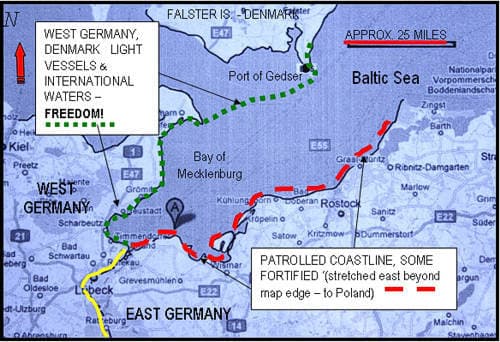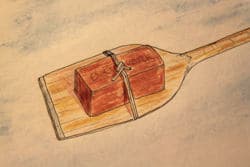Paddling to Freedom
The following story is based upon a conversation with a wilderness lodge owner in Kodiak, Alaska. Dieter escaped from East Germany with a friend in a double Klepper folding kayak out across a section of the Baltic Sea. This is his story of paddling to freedom…
Dieter was drenched by each wave washing over the deck as the bow sliced through the chilling waters of the Baltic. He was sick and was repeatedly vomiting over the side of the Klepper kayak; his stomach was as turbulent as the northern waters he and his partner were battling. They pushed the kayak through the darkness, putting miles between them and the coastline patrolled by the East Germans. He grabbed his paddle and mustered enough strength to pull the wooden blade through the icy black water for a few more agonizing strokes before his stomach erupted again. Dieter was paying the price of freedom…
A Captive State
Two Germanys emerged after WWII. The free West Germany and its Cold War rival, the communist controlled East German (German Democratic Republic-GDR). A portion of both Germanys' northern border is the Baltic Sea. It posed a significant barrier to freedom when Cold War security measures included the coastline east of the river that demarked the border between the two countries. Fortifications, known as the "Blue Border" of the GDR covered the coast near the West German border. Watchtowers, fences and walls stood sentry near marshes. High-speed Patrol boats (Dieter referred to them as wolf packs, a name given to the German U-boats that attacked allied ships crossing the Atlantic) stalked the shoreline ready to pounce on any suspect craft found in East German waters.
Other stretches of the coast were covered by security patrols all the way to the Polish border. Even some island had security controls imposed upon them. Anyone attempting an escape by sea, like all other forms of seeking freedom, did so against nearly insurmountable, life-threatening odds.

Early Attempts at Freedom
Dieter was well aware of the escape efforts that had been attempted for many years - those that succeeded as well as those that sadly failed. Desperation drove potential escapees to try every means possible including: tunnels, secret compartments in vehicles, make-shift raft river crossings, hot air balloons, open sea routes and countless attempts on foot. His first effort was a scheme to escape across the border by sneaking aboard one of the many trains crossing the border into West Germany.

His plan was simple: Under the cover of the dark of night climb he would climb up into the open-topped water tank at a railroad watering stop just inside the border. Spending hours in icy-cold, chest deep water, he would wait for a train to stop so he could climb onto the undercarriage of a car and ride it across to freedom. Waiting hours for an approaching train was risky on several accounts, the least of which was dying from hypothermia.
The East Germans were onto most of the escape tactics and foiled many before they could even be attempted. Such was the case for Dieter. On many occasions he spent long, cold nights in the water tank waiting for trains that never arrived. The Germans would randomly change the routings to other crossings at the very last minute possible. Dieter finally decided to come up with another escape plan. He would kayak out onto the Baltic Sea and paddle to the free coastlines of West Germany or Denmark – or die trying!
Barriers to Freedom
All activity along the Baltic Blue Border was severely limited and monitored via 27 watchtowers and patrols with high-powered searchlights. Fugitives were reported to high-speed powerboats patrolling the waters, ready to intercept any escapees. Those who did manage to flee from the beaches had several options for freedom: hit the Danish coast somewhere along Falster Island, reach the coastal area of West Germany at the head of the Bay of Mecklenberg, be rescued by a Danish light vessel (basically a ship designed as an ocean-going light house) or hopefully be picked up by friendly freighters enroute along sea lanes in international waters.
Dieter's plan was simple and extremely risky. He would use a two-person folding kayak and paddle out from East Germany and then back in to West Germany and freedom.
A Year of Preparation
Procuring any kind of watercraft would create instant suspicion for a person living near the coast as Dieter did. He decided to travel far inland, to southern East Germany, to pick up a boat and necessary gear. Back at his apartment, he began a regime of training that included tying a brick to the blade of each kayak paddle and going through the paddling motions every chance he had. The weight training would hopefully give him and his partner the stamina and endurance needed to make the long and dangerous trip.

They would have to debark far to the east of the highly fortified and patrolled border junction at the northern coastline. They would have to venture far out into the Baltic to avoid all coastal activity. And they would have to complete their escape route completely under the cover of night.
Out of the Darkness – Into Freedom
Dieter didn't have much detail to share about the actual night of the escape. They knew their freedom and lives depended upon succeeding. I got the impression that neither Dieter nor his paddling partner had any intentions of giving up or turning back. The only details of the actual trip still fresh in Dieter's mind were those of him being violently sick during the last half of the ordeal. He was so ill that his partner had to do most of the paddling.
I don't recall where they finally pulled to shore, but it was on a free beach! Dieter remembers retracing his route on a chart and figures they covered about 80 miles in twelve hours. That converts to just over 6.5 miles per hour – steady! That's quite a feat in a not-so-sleek Klepper. The race for freedom is usually always fueled by adrenalin.
The Cost of Freedom
According to some of the websites I reviewed for background info on the GDR's border restrictions it is estimated that nearly 200 people died in escape attempts via the Baltic Sea. Dieter and his fellow kayaker were among the lucky ones who made it!
More information on the East/West German borders from 1949-1990, including enforcement along the Baltic Sea and other rivers, is available at the following Wikipedia link: wikipedia.org/wiki/Inner_German_border#East_Germany.27s_sea_border
Tom Watson is an avid sea kayaker and freelance writer. He also posts articles and thoughts on his website www.wavetameradventures.com. He has written 2 books,"Kids Gone Paddlin" and "How to Think Like A Survivor" that are available on Amazon.com.
Related Articles
Watch in awe as Spanish kayaker Aniol Serrasolses descends more than 25 kilometers by kayak from Chile's…
Sergi Basoli set off on a kayaking expedition on the Mediterranean Sea and he ended up finding his best…
**Warning: There are a few NSFW words in this video** "Watch as Grady Flynn breaks boat in half on last…
Follow the world's greatest kayaker and adventure icon, Trip Deacon while he pushes action sports to new…



